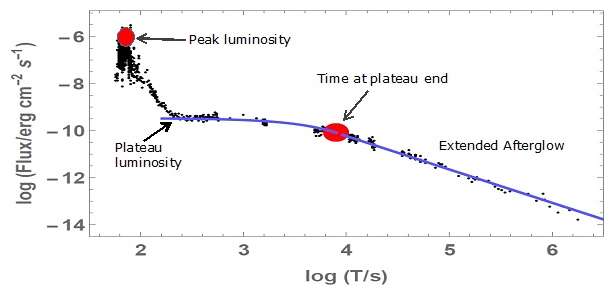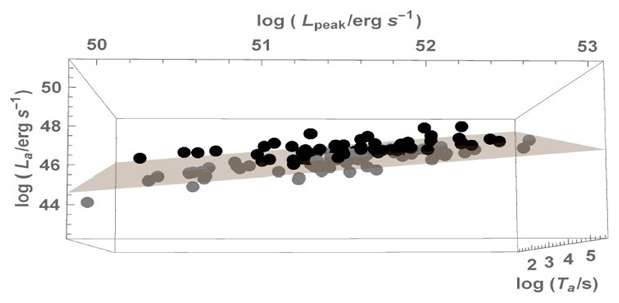Swift gamma-ray bursts—a 3D step toward standard candles

A new way to use the most powerful explosions in the Universe to calibrate its expansion has been developed by a team of researchers (Sergey Postnikov, Xavier Hernandez from Institute of Astronomy , UNAM, and Michal Ostrowski from the Astronomical Observatory of Jagiellonian University) led by Marie Curie Outgoing Fellow at Stanford University, Maria Dainotti. Dainotti recently presented the results of her team's work at a press conference at the 228th meeting of the American Astronomical Society. Dainotti's three-dimensional analysis shows that a specific population of gamma-ray bursts can be used to provide an independent measurement of the cosmic distance scale. Since gamma-ray bursts are even brighter than supernovae, this new technique has the potential to extend the cosmic ruler to greater distances than are currently possible.
Astronomers refer to these cosmic rulers as "standard candles" - objects with a known intrinsic luminosity. Once the absolute luminosity is known, the distance to that object can be calculated based on its measured brightness. For example, a 100 Watt lightbulb will appear four times dimmer when it is twice as far away.
"This 3D correlation, since it is the tightest among the prompt-afterglow ones so far in the literature, will offer the opportunity to estimate the cosmological parameters and then allows a direct investigation of the cosmological evolution of the Universe up to epoch of reionization", said Dr. Dainotti.
Although supernova explosions are very bright, the useful range over which they can be used as standard candles extends out only to distances of around 11 billion light years (redshifts up to 2.4). In contrast, GRBs can be studied out to distances of 13.2 billion light years (redshifts as great as 9.4). Studying the very early Universe is critical to understanding the details of cosmological evolution; e.g., the characteristics of dark energy from the epoch of reionization to the present.

Many previous studies have attempted to use different features of the light emitted by GRBs to define standard candles. However, even when all the GRBs are observed in a uniform manner with, e.g., NASA's Swift satellite, these features are seen to vary widely over orders of magnitude. This applies not only to the prompt emission (the main event in the gamma rays), but also to the extended afterglow phase (which follows the prompt emission and is seen over a range of wavelengths as the embers from the explosion cool). To complicate matters further, no single clear explanation as to the physical nature of GRBs exists. Possible causes range from the collapse of massive stars, to magnetars in the process of spinning down, to the collapse of supernovae, to binary mergers.
Over the past decade, many efforts have been made to find correlations between characteristic parameters that can be measured using GRBs. Previous efforts looked for relationships among pairs of parameters. Dainotti's idea was to introduce a third parameter to tighten the correlation and increase the utility of GRBs as standard candles. This proved to reduce the scatter in the data points within the group of long GRBs (duration greater than 2 s). The parameters that Dainotti found worked the best to provide accurate distance indicators were the observed luminosity at the GRB peak, the time that the afterglow plateau end and the luminosity during the afterglow. These results were verified by using Monte Carlo simulations to prove that the 3D correlation was not a random effect due to the GRBs that were used in the analysis.
More information: The paper 'A fundamental plane for gamma-ray bursts with X-ray plateaus' by Dainotti, M. G., Postnikov, S., Hernandez, X., & Ostrowski, M. has been accepted for publication in the Astrophysical Journal, Letters. The preprint can be downloaded from: arxiv.org/abs/1604.06840
Provided by NASA




















